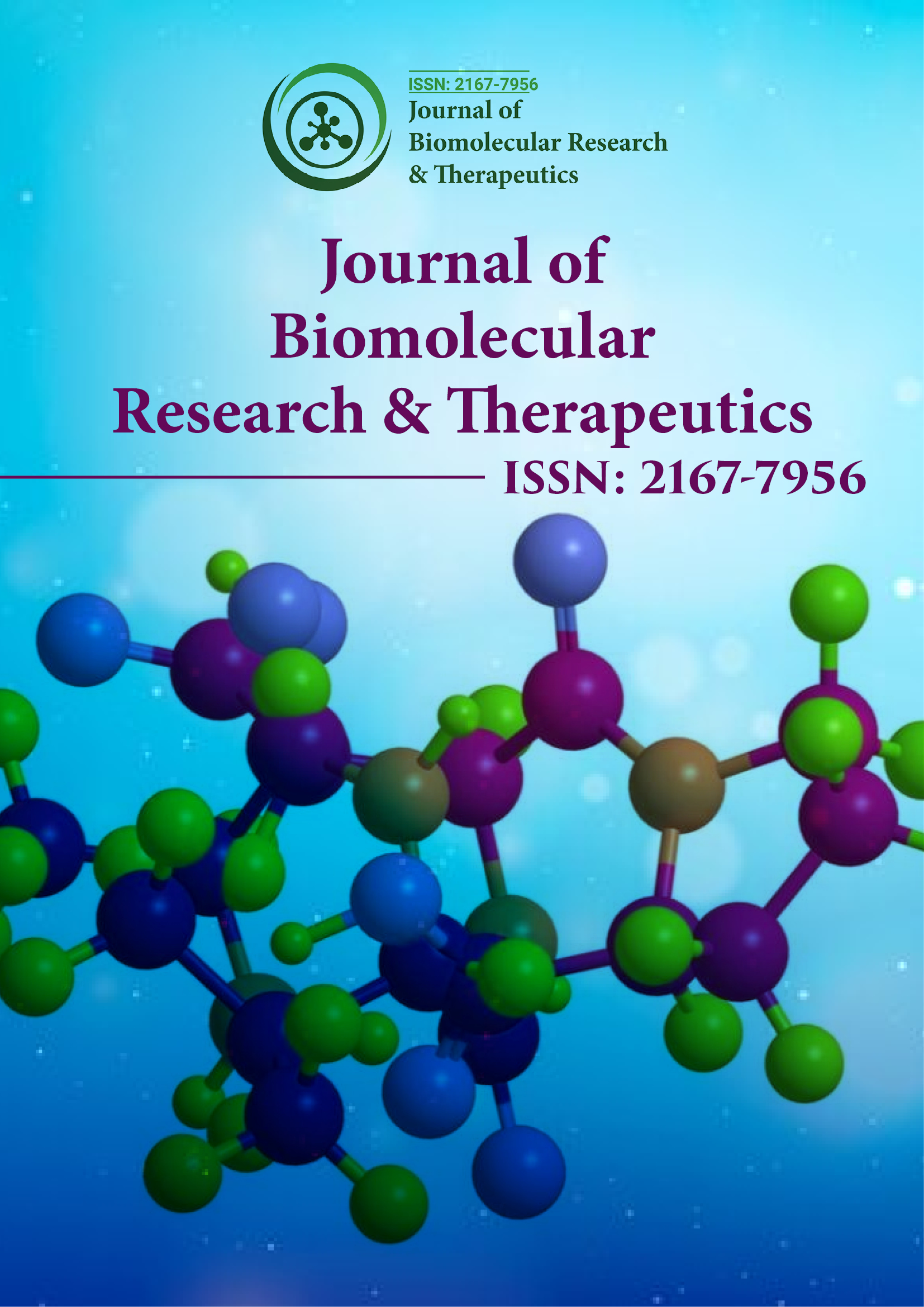ఇండెక్స్ చేయబడింది
- J గేట్ తెరవండి
- జెనామిక్స్ జర్నల్సీక్
- పరిశోధన బైబిల్
- ఎలక్ట్రానిక్ జర్నల్స్ లైబ్రరీ
- RefSeek
- హమ్దార్డ్ విశ్వవిద్యాలయం
- EBSCO AZ
- OCLC- వరల్డ్ క్యాట్
- SWB ఆన్లైన్ కేటలాగ్
- వర్చువల్ లైబ్రరీ ఆఫ్ బయాలజీ (విఫాబియో)
- పబ్లోన్స్
- యూరో పబ్
- గూగుల్ స్కాలర్
ఉపయోగకరమైన లింకులు
ఈ పేజీని భాగస్వామ్యం చేయండి
జర్నల్ ఫ్లైయర్

యాక్సెస్ జర్నల్స్ తెరవండి
- ఆహారం & పోషకాహారం
- ఇంజనీరింగ్
- ఇమ్యునాలజీ & మైక్రోబయాలజీ
- క్లినికల్ సైన్సెస్
- జనరల్ సైన్స్
- జెనెటిక్స్ & మాలిక్యులర్ బయాలజీ
- నర్సింగ్ & హెల్త్ కేర్
- న్యూరోసైన్స్ & సైకాలజీ
- పర్యావరణ శాస్త్రాలు
- ఫార్మాస్యూటికల్ సైన్సెస్
- బయోఇన్ఫర్మేటిక్స్ & సిస్టమ్స్ బయాలజీ
- బయోకెమిస్ట్రీ
- మెటీరియల్స్ సైన్స్
- మెడికల్ సైన్సెస్
- రసాయన శాస్త్రం
- వెటర్నరీ సైన్సెస్
- వ్యవసాయం మరియు ఆక్వాకల్చర్
- వ్యాపార నిర్వహణ
నైరూప్య
లుటియోలిన్ మరియు రెస్వెరాట్రాల్తో డోక్సోరోబిసిన్-కెమోథెరపీ చికిత్సను మెరుగుపరచడం: లుటియోలిన్ మరియు రెస్వెరాట్రాల్తో రూపొందించబడిన ఒక నవల సింథటిక్గా ఇంజినీర్డ్ సెకండరీ మెటాబోలైట్ "TDB-13"
ఫస్ట్-లైన్ కెమోథెరపీ డ్రగ్ డోక్సోరోబిసిన్, ఇప్పటి వరకు అత్యంత శక్తివంతమైన కెమోథెరపీ ఔషధం, వాస్తవంగా అన్ని కెమోథెరపీ చికిత్స ప్రణాళికలలో ఉపయోగించబడుతుంది. 92% కేన్సర్ రోగులు గత ఆరు దశాబ్దాలుగా కీమోథెరపీతో చికిత్స పొందుతున్నారు, కీమోథెరపీ 90% వైఫల్య రేటును కలిగి ఉంది. అధిక శాతం వైఫల్యాలు డోక్సోరోబిసిన్ యొక్క దుష్ప్రభావాలకు కారణమని చెప్పవచ్చు. డోక్సోరోబిసిన్ యొక్క చికిత్సా సామర్థ్యాన్ని గణనీయంగా తగ్గించకుండా దాని యొక్క పరిణామాలను తగ్గించే ప్రస్తుత చికిత్స ఏదీ లేదు.
ఇతర రసాయనాలు/సమ్మేళనాలతో పనిచేసేటప్పుడు ద్వితీయ జీవక్రియలు మెరుగుపడతాయని మరియు లూటియోలిన్ మరియు రెస్వెరాట్రాల్ ప్రత్యేకంగా గుండె కణజాలంపై రక్షిత ప్రభావాలను కలిగి ఉన్నాయని పరిశోధనలు సూచిస్తున్నప్పటికీ (ఇది ఒక ప్రధాన దుష్ప్రభావాన్ని తగ్గించగలదు: కార్డియోటాక్సిసిటీ), ఏ పరిశోధన ఏ కీమోథెరపీ ఔషధంపై ద్వితీయ జీవక్రియలను పరీక్షించలేదు. . చికిత్సా సామర్థ్యాన్ని అంచనా వేయడానికి: లుటియోలిన్, రెస్వెరాట్రాల్ మరియు డోక్సోరోబిసిన్ కార్సినోమా యొక్క విట్రో మోడల్లలో (అన్ని క్యాన్సర్ కేసులలో 80%-90%) ఒంటరిగా మరియు త్రయం వలె చికిత్స చేస్తారు. కార్డియోటాక్సిసిటీ యొక్క దుష్ప్రభావాన్ని పరీక్షించడానికి: ఎక్స్ట్రాసెల్యులర్ మ్యాట్రిక్స్ భాగాలు కార్డియోమయోసైట్ల ఉపరితలంపై పూత పూయబడ్డాయి.
లుటియోలిన్ మరియు రెస్వెరాట్రాల్ ఫలితాలు మాత్రమే అవి ఇన్ విట్రో కార్సినోమా కణాలకు చికిత్సగా ఉన్నప్పటికీ , ఒక బలహీనత ఉందని సూచిస్తున్నాయి: ఒక చిన్న చికిత్సా విండో (15 μM మరియు 20 μM సాంద్రతలు 5 μM మరియు 10 μM యొక్క అత్యల్ప సాంద్రతలతో సమానంగా లేదా తక్కువ ప్రభావవంతంగా ఉంటాయి. ) — లుటియోలిన్ మరియు రెస్వెరాట్రాల్ జనాదరణలో పెరిగినట్లు సూచిస్తున్నాయి (ఇన్ ఆహార పదార్ధాల రూపం) 2010 నుండి 82% క్యాన్సర్ రోగులలో, సమ్మేళనాలు ఎల్లప్పుడూ ఆశించిన ప్రభావాన్ని ఉత్పత్తి చేయకపోవచ్చు. లూటియోలిన్ మరియు రెస్వెరాట్రాల్ను డోక్సోరోబిసిన్తో కలపడం వల్ల కార్డియోటాక్సిసిటీని తగ్గించేటప్పుడు డోక్సోరోబిసిన్ యొక్క చికిత్సా సామర్థ్యాన్ని మెరుగుపరచగలిగారు. అయినప్పటికీ, ఒక చిన్న చికిత్సా విండో యొక్క బలహీనత ఇప్పటికీ ఉనికిలో ఉంది. లుటియోలిన్ మరియు రెస్వెరాట్రాల్ రెండింటి యొక్క మిథైలేషన్ మరియు గ్లైకోసైలేషన్ ద్వారా, "TDB-13" అనే ప్రస్తుత అధ్యయనం చికిత్సా విండోను పొడిగించేటప్పుడు చికిత్సా సమర్థత మరియు కార్డియోటాక్సిసిటీ తగ్గింపు స్థాయిని నిర్వహించగలిగింది. అందువల్ల, కీమోథెరపీ చికిత్సలో కొత్త భాగాలు దానిని బాగా మెరుగుపరుస్తాయి.